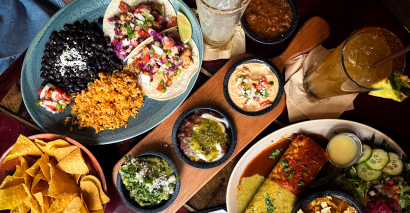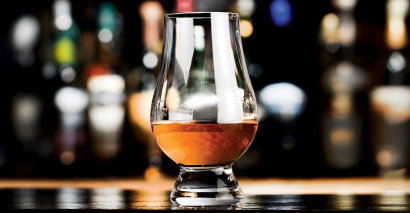
Jimadors harvest blue agave in Santa Cruz de Bárcenas, Jalisco, Mexico. (DON COUCH / ALAMY STOCK PHOTO)
Tequila’s roots grow deep. Mexico’s native spirit has a rich history and an even richer sense of place. Nowadays, thanks to rising interest from spirits sippers and cocktail enthusiasts, its sales are booming. Like scotch whisky and cognac, tequila’s production is highly regulated, with the Mexican government imposing restrictions and quality standards to maintain integrity. Thanks to those efforts, tequila has upped its game over the years to win a place alongside the world’s most connoisseurial spirits.
At its heart, tequila is all about agave. A succulent native to hot, arid regions of the Americas, agave is the base for all tequilas. There are many types of agaves, though only one can be used to make tequila: agave tequilana, the Weber Azul or blue agave, native to western Mexico. For tequila, that particular varietal can only be sourced from five Mexican states: Jalisco, where the majority of tequila is made, and within certain municipalities of Guanajuato, Michoacán, Nayarit, and Tamaulipas.
Blue agaves grow into large plants with spiky leaves that can reach up to 8 feet tall, with a stalk in the middle that can grow even higher and sprout flowers. Tequila producers usually cut the stalk as it grows to bulk up the agave’s heart, which is the key piece for making tequila. Jimadors—the Mexican farmers who harvest agave plants—prefer blue Weber agave for tequila for two primary reasons: It has a higher sugar concentration than most agave varieties, and it grows and matures a bit faster than other types, meaning it can be replenished more quickly. In addition, blue agave can be harvested year-round. Agave is placed in tanks for steaming CAVAN IMAGES / ALAMY STOCK PHOTO
Agave is placed in tanks for steaming CAVAN IMAGES / ALAMY STOCK PHOTO
Historical Context
Mexico’s Consejo Regulador del Tequila—the governing agency that oversees tequila—estimates that the spirit dates back to the 16th century under Mexico’s Spanish rule, though tequila production wasn’t legalized in the country until the 17th century. Its place was solidified in the 1800s, following Mexico’s independence from Spain and its civil war, and it grew further in the 1900s as tequila became a symbol for the country both domestically and abroad. Tequila exports steadily grew as the Mexican government began implementing laws to regulate how the spirit can be made.
Mexico’s most recent Protection for the Appellation of Origin for tequila was adopted in 1974 and still holds today, stating that tequila can only be made within specific parts of the country from the blue agave plant. The U.S. signed an agreement with Mexico recognizing tequila as a distinctive product exclusive to Mexico in exchange for Mexico doing the same for bourbon.
Tequila’s agave growing region is often denoted as either Highlands or Lowlands, based on where in Jalisco the plant is grown, creating a unique terroir for the spirit. Traditionally, the Highlands, or Los Altos, tend to have more precipitation, which creates a richer soil that produces sweeter agave, resulting in a more fruit-forward, floral tequila. The Lowlands, or El Valle, has volcanic soil and less water, creating a spicier, herbal, more earthy, more vegetal tequila. Cooked agave is crushed. RICHARD ELLIS / ALAMY STOCK PHOTO
Cooked agave is crushed. RICHARD ELLIS / ALAMY STOCK PHOTO
Production Notes
Blue agave is abundant in Mexico’s tequila-producing region. Jimadors harvest the agave by cutting the leaves and stalks off the plant, leaving the piña, or heart. A piña can weigh anywhere from 80 to 200 pounds. Once harvested, the piñas are roasted or baked to convert their raw sugar into more fermentable sugars. Some tequila producers slow-roast their piñas in traditional ovens for a couple of days, while others use an autoclave—a more modern, steam-fueled pressure cooker—to heat the piñas more quickly. After baking, the piñas are shredded or crushed to extract the agave juice, called aguamiel, for fermentation. For 100% agave tequilas, only agave sugars can be used, but for mixto tequilas additional sugars totaling no more than 49% of the mixture can be added prior to fermentation. After fermentation converts the sugars to alcohol, distillation begins in copper or stainless steel stills. Tequilas can go through multiple distillation cycles to increase purity. Copper pot stills and barrels aging JORGE GARRIDO / ALAMY STOCK PHOTO
Copper pot stills and barrels aging JORGE GARRIDO / ALAMY STOCK PHOTO
Most lower-priced tequilas popular in the U.S. go through two distillations to be called blanco or silver. At that point, they can be bottled, or blended with an already aged tequila to create the gold or joven style. Those spirits labeled gold or joven have usually been blended with reposado or añejo tequila, and some are also enhanced with mellowing agents like caramel coloring and oak extract.
Aged tequilas have shown remarkable growth over the last decade. Under the Mexican classification system, there are three types of aged tequilas—reposado, añejo, and extra añejo—and each must be aged in oak to be called tequila. Meaning “rested” in Spanish, reposado is the entry-level aged tequila. To be called reposado, a tequila must sit in oak for a minimum of two months. To be labeled añejo, or extra-aged, the spirit must sit for at least 12 months in oak containers with a maximum capacity of 600 liters. Extra añejo—ultra-aged—must sit for at least 3 years in oak containers with a maximum capacity of 600 liters. At Jose Cuervo’s La Rojeña Distillery MICHAEL DEFREITAS CENTRAL AMERICA / ALAMY STOCK PHOTO
At Jose Cuervo’s La Rojeña Distillery MICHAEL DEFREITAS CENTRAL AMERICA / ALAMY STOCK PHOTO
Many distillers age their tequilas in American whiskey barrels, though some also use French oak and cognac barrels or oak from other countries, and some even use new oak. The barrels are usually stacked in a rack-house, and some producers mist or spray water on the ground of the aging rooms to keep the area moist and cool. The Mexican government has bottling regulations in place to ensure consistency and quality for its native spirit. Mixto tequilas can be sent in bulk containers outside of Mexico to be bottled at facilities that follow Mexico’s strict guidelines, but 100% agave tequilas have to be bottled within the tequila-producing regions of Mexico to bear the pure agave label. All tequila bottles have a four-digit code, called a NOM—Norma Oficial Mexicano—showing that it meets the Mexican government’s standards for tequila.
Mixto vs. 100% Blue Agave Tequilas
 Blue agave PANORAMIC IMAGES / ALAMY STOCK PHOTO
Blue agave PANORAMIC IMAGES / ALAMY STOCK PHOTO
While there are many brands and styles of tequila available today, the spirit can only be classified in two ways based on how it’s made: 100% agave and mixto. Both have an important place within the spirit’s history and each has its own applications for sipping or mixing into cocktails.
All tequilas, regardless of type, must be made from the Weber blue agave plant sourced from one of five states in Mexico. Tequilas labeled as 100% agave must be made using only the sugars from Weber blue agaves, while mixtos need only contain 51% agave sugars, with the remaining percentage allowed to come from other sugar sources like cane syrup, molasses, or high fructose corn syrup. By Mexican law, any sugar additives in mixto must go in before fermentation.
Additionally, 100% agave tequilas must be bottled at a facility in Mexico authorized as a tequila producer by the Mexican government, and they must be labeled as either “100% agave” or use a similar approved phrase, such as “100% puro agave.” Mixto tequilas, however, are simply labeled “tequila” and can be bottled abroad at facilities that are not owned by an authorized producer as long as they follow regulations ordered by the Mexican government, a change that began in 2006. All tequila producers—both mixto and 100% agave makers—are allowed to add a limited amount of mellowing additives, like caramel coloring, oak flavoring, or glycerin to their spirits after distillation, as long as they total less than 1%.
Tequila is named for the municipality in Jalisco where it was first made, and estimates date its early roots back to the 16th century. The spirit’s popularity grew steadily over several centuries and by the 1940s, tequila exports had reached new highs. At that time, all tequilas were 100% agave based. Mixto tequilas were introduced in the 1960s and ’70s, when the demand for tequila was fast outpacing supply, and Mexico’s government loosened its restrictions on agave makeup to meet consumer needs. Agave plants can take up to 10 years to mature, so there were not enough usable plants to make tequila, thus regulators allowed for less agave distillate in the spirit. The requirement of 70% agave in 1964 was decreased to 51% in 1970.
Mixto tequilas were born from good intentions—to keep momentum going—but what followed caused big problems for tequila producers, as mixtos gained a reputation for being cheaply made. That changed in the 1990s when tequila’s image began a major transformation when producers began to embrace quality by focusing on 100% agave tequila. Today, according to Impact Databank, 100% agave tequilas account for around 65% of sales in the U.S.
While mixto tequilas are firmly rooted in mixology and do well in cocktail staples like the Margarita, 100% agave tequila has become the go-to for most tequila lovers, earning a spot on the top shelf, on par with whisky.




![A Look Back at the Last 25 Years of Whisky [Part III: 2020-2025]](/get/files/image/galleries/25_years_part_3_hero.png?resize=410x0)